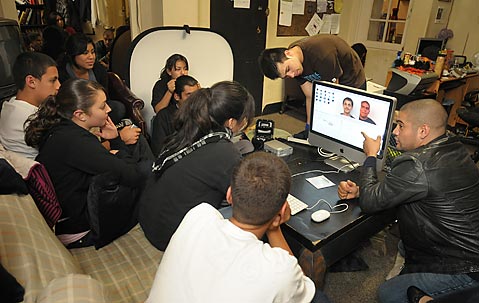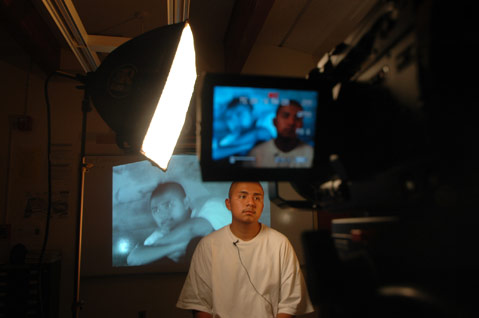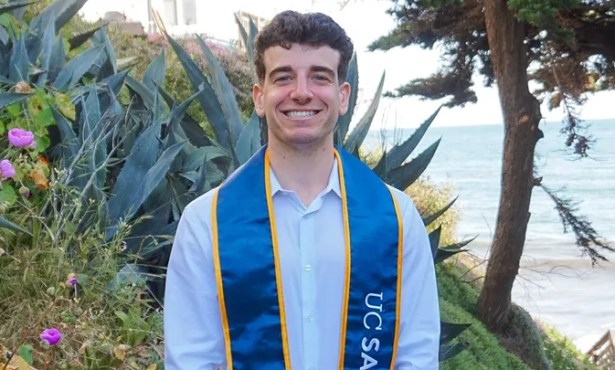Fighting Gangs with Film
Program Gives "High-Risk" Kids an Alternative to Gangbanging

Since a group of teenagers attacked and killed another teenager in the middle of downtown Santa Barbara on a sunny March 2007 afternoon, everyone – from city councilmembers and cops to business owners and schoolteachers – has been up in arms about what to do about “the gang problem.” Amid committees being formed, speeches being delivered, editorials being written, and neighborhoods being raided, another two teenagers have been stabbed to death and violent battles between the Eastside and Westside gangs – including one incident involving gunfire and a Molotov cocktail on De la Vina Street – occur almost weekly. There has been plenty of talk and some effective police activity, but very little progress in giving these mostly lower-class Latino kids an alternative to gangbanging.
founded in January 2003 by filmmaker and activist Osiris Casta±eda, offers practical video, photography, and graphic design training for these teenagers, giving them real-world experience working on contracted projects and leaving them with the skills they need to find jobs on their own. The program is just one of six in Santa Barbara targeting “hardcore, high-risk” kids-including some who step in and out of gang life and drug use-and the only one in town educating this demographic every single day of the week. And it’s popular, with about 50 students coming multiple times each week.
But despite its effectiveness in offering these difficult-to-reach kids a daily excuse to avoid gangbanging, Youth CineMedia must continually fight for money to stay alive, and not just as a result of the fierce competition for donations against long-standing “at-risk youth” programs, which don’t really appeal to the hardcore element. The deeper problem is that what it takes to attract these kids and keep them coming-a laid-back, cool, colloquial atmosphere where the conversation is honest but not always politically correct-is not an easy thing to show off to the philanthropists, foundations, and government agencies that donate money to such causes. The challenge, then, for Youth CineMedia and similar hardcore-targeting programs is: Can they remain rough enough to save the tough kids, but become smooth enough to bring in the dough?

In the Studio
Throughout the years, there have been various incarnations of Youth CineMedia all over town, from its early beginnings at Santa Barbara Junior High to its trips through La Cuesta Continuation High School and a little hole-in-the-wall behind the Unity Shoppe. In 2005, when Casta±eda won a $250,000 federal grant from the Department of Education, he used the money to bulk up the program by buying new cameras, computers, and other equipment. Since 2007, Youth CineMedia has functioned under the umbrella of Zona Seca, the 38-year-old nonprofit on West Figueroa Street that’s mainly focused on court-mandated drug, alcohol, and domestic violence rehabilitation programs. Today, headquarters is in a classroom at the Westside Community Center, where rent is covered thanks to sponsorship from the Granada Theatre. (The Granada also recently hired Youth CineMedia to do PSAs for its teen program.)
During an afternoon visit in September, more than a dozen kids were in the studio, some working on video editing projects, some taping interviews, some making hip-hop beats, some culling through digital photographs, and some just hanging out in a safe place. Although twice the age of some of his students, Casta±eda blends right in, which is one of the reasons the kids feel comfortable around him. Using the kids’ own slang, he tried to coax his students to explain why they come to the program. “This gives us an excuse to not be on the streets,” explained one student. “What else are you going to say? ‘I’m going to go help my mom cook’?”
Another kid finally blurted out, “He can teach you how to get a job and get paid!” It seems sad that making money has to be what a young teenager is worried about, but that’s the reality for these kids, and it’s where Youth CineMedia shines. “So many youth programs are trying to help, but they don’t give them the two things they need the most, which is a job and self-esteem,” explained Casta±eda. “If these guys can get a job, they eventually stop banging. Keeping kids busy is the solution.”
One former student agrees. “It kept me out of trouble,” said Steve, who participated in the program years ago while in the eighth grade and turned his experience into a job at Kinko’s, where he became a supervisor within two years. “We come up with an idea, and he helps us make it happen.”
The students, who are mostly Latino, are working on one or more of the 30-plus projects being developed at any given time. These include educational videos for the City of Santa Barbara’s Creeks Division, public service announcements for the County of Ventura’s AIDS program, and print advertising design for Tinta Latina, El Mexicano de Santa B¡rbara, and Shape of Voice, all examples of contracted work that pays participants $10 an hour. These relationships are what Casta±eda sees as the future of the program, which he’s poising to grow into a self-sustaining video production and graphic design firm-if he can get the seed money needed to ramp it up to a level where Youth CineMedia can compete with other private firms.
Other students are working on films about school life and public health. With the help of Casta±eda’s fiancee Regina Ruiz-a former KEYT reporter who now volunteers full-time with the program, hoping to bring in more young women-a student named Melissa is documenting the increasing use of methamphetamine as a diet drug by high school girls. One video on the Youth CineMedia Web site tells the story of a teenage mother and her baby girl, where another details what it’s like to grow up around gangs in Santa Barbara.
Perhaps the most powerful pieces still in production are the memorials for stabbing victims Lorenzo “Nemo” Carachure (killed on San Pascual Street on July 16, 2007) and Emmanuel Roldan (killed on Cabrillo Boulevard on July 4, 2008). Those films, which feature tearful interviews with the victims’ parents and powerful pleas for an end to the violence from friends and relatives, will premiere at the Santa Barbara International Film Festival in January 2009. “We’re doing it out of respect for the homie,” explained one of the Nemo tribute filmmakers in his thick street drawl. “We want to let people know he wasn’t just into gangbanging. He was a good friend. He brought good things to our life. He was cool to kick it with.”
So why don’t these kids go to the Westside Boys & Girls Club, the city’s 1235 Teen Center on Chapala Street, or any of the other programs targeting “at-risk” youth? “Because you don’t learn anything-you just play games or shoot pool,” said the other Nemo filmmaker, further explaining, “there’s really no Mexicans that go there.” Some of the kids said they’ve actually been kicked out of such places or that they fear narcs are lurking there, ready to tell on them for swearing, hanging out with the wrong people, and other offenses they deem ridiculous.
Because Santa Barbara is a small town with plenty of politics involved, Casta±eda can’t afford to be critical of other programs. But he’s not afraid to hide his frustration that some of the same programs seem to get all the money while he has to fight for every dollar that comes to Youth CineMedia, which he sees as uniquely successful at helping the high-risk kids. “I don’t know what the other people do,” he explained, “but I know that what we do works.”
Casta±eda’s former student Steve, however, spoke a little more freely about the other programs in town. “They don’t work,” he said. “They really don’t work.” On the other hand, when it comes to Youth CineMedia, Steve explained, “If you’re in the ‘hood, people talk about this place.”

Show Them the Money
If the goal of Youth CineMedia is to become a self-sustaining video production and graphic design firm, how much money will it take to make that happen? According to Frank Ba±ales, Zona Seca’s executive director, about $250,000 would probably be enough for the first year’s annual budget, which would allow the business to get off the ground.
But he knows finding that money for a relatively new project can be difficult, especially in a town where long-standing “at-risk” programs automatically get the money. “When you have to compete with these programs that have been around forever, you’re just not going to attract that support,” said Ba±ales, who also is not critical of those programs, just bothered by the system.
Ba±ales and his board-which currently is undergoing unprecedented growth, jumping from just four members a year ago to 10 and counting-believe wholeheartedly in Youth CineMedia because it is one of only six programs in Santa Barbara targeting the hardcore, high-risk population. The other five are Primo Boxing Club, All-for-One, Y Strife, Los Compadres, and Surf-to-Turf, but most of those still aren’t offered daily, as Youth CineMedia is. “These are the only ones that really target this population and have been working with them for quite a while,” he said, adding that the other similarity is all six barely manage to stay afloat. “But if these programs weren’t out there, the problem in the community would be much worse.”
Ba±ales freely admits that Zona Seca cannot maintain Youth CineMedia forever, especially since it’s the only program under the nonprofit that doesn’t support itself. Zona Seca has never been much for fundraising, but because of the promise of Youth CineMedia and the rise in teen violence, the expanded board decided to support it nonetheless. “But it’s a year-to-year thing for us,” he explained. “Each year, we have to make the decision of what we’re willing to risk. You can’t sacrifice all of our programs for one program, no matter who you’re working with.”
In October’s board meeting, its members decided to support Youth CineMedia at least through June 2009, a decision that was aided in part by a $17,000 grant from the Santa Barbara Foundation, which Ba±ales sees as a donor stamp of approval. They’ve also helped raise other funding, but the program is already behind budget this year.
Both he and Casta±eda see a promising model in Homeboy Industries, a 20-year-old job program out of Los Angeles that’s expanded into a bakery, cafe, silkscreen shop, and retail store. “We have that potential with this program,” said Ba±ales. “But like any enterprise, you have to have investment dollars to get started.”
Oddly, thanks to the recent rise in gang activity, Ba±ales is hopeful that now might be the right time to get that money. “There is only a certain window of opportunity for this community, and that is when someone gets murdered on State Street,” he said. “The window is still open, but it’s starting to close.”
Compounding the problem in Ba±ales’s eyes is that he believes society has already given up on many of these high-risk kids, an attitude that is needed for everyone to support the wide-ranging police raids and gang suppression strategies. “Because of that perception, people give up on them,” he explained. “And when they give up on them, they have no hope.”
According to Casta±eda, giving up on these kids at this point is the wrong way to go. “The truth is these are really good, respectful people, who say, ‘Yes, ma’am,’ and open the door for their girlfriends,” he explained. “These guys aren’t that lost. They can turn it around.”
4•1•1
For more information, see youthcinemedia.org or tune in to YCM’s new “Street Focus” column at independent.com/street-focus.



